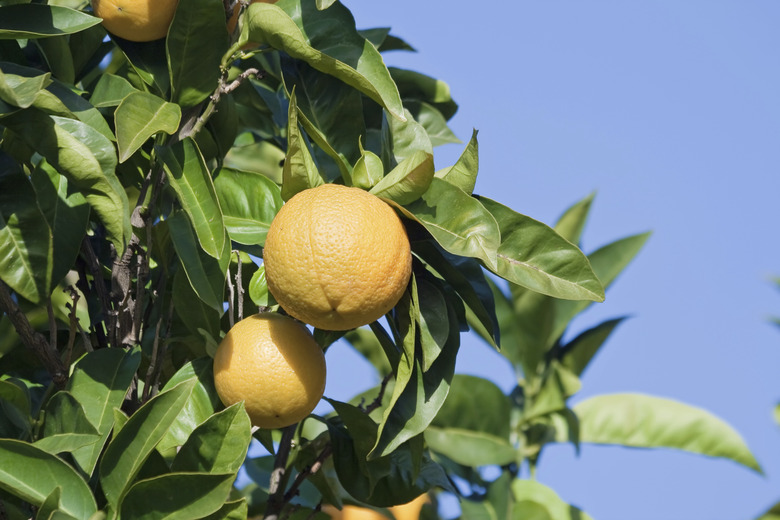Types Of Texas Oranges
Both the subtropical climate and the sandy-loam soil of the lower Rio Grande Valley make it perfect for growing oranges, and it's where 90 percent of oranges are grown in Texas. While oranges may be grown in other warm areas of Texas, they cannot withstand periodic freezes.
Step 1
Regular round oranges of the type the most often grown worldwide are difficult to peel. Navel oranges, typically easy to peel, have a secondary fruit embedded in their blossom, creating a "navel." Several varieties of blood oranges are grown in Texas, but they usually do not develop the dark red color for which the variety is known — however, these are the easiest orange trees for home gardeners to grow. Choose orange trees grafted onto sour orange rootstock. Oranges like deep, well-drained, loamy soil and full sun. If your soil is heavy clay or doesn't drain well, orange trees will grow poorly with a small yield and won't live long. If you live in a warm area outside of the Rio Grande Valley, plant orange trees on the south or southeast side of your house to protect them from the cold. Plant them at least 12 feet from buildings, sidewalks and driveways to allow for their spreading roots.
Step 2
- Regular round oranges of the type the most often grown worldwide are difficult to peel.
- Several varieties of blood oranges are grown in Texas, but they usually do not develop the dark red color for which the variety is known — however, these are the easiest orange trees for home gardeners to grow.
Valencia Oranges
Step 1
The most widely planted orange variety in the world, the large, slightly oblong "Valencia" orange (Citrus sinensis "Valencia") grows in U.S. Department of Agriculture plant hardiness zones 9a through 11. Valencia has a moderately thick peel and is seedless. The color of and quality of its juice and the color of its peel are all excellent. In Texas, it matures in early February and the oranges remain on the tree into summer.
Step 2
Other Round Oranges
Step 1
Medium large, round "Parson Brown" (Citrus sinensis "Parson Brown") has a thick, pebbly skin and matures in early September in the Rio Grande Valley. Both the juice and juice color are of poor quality. Small with a smooth peel, "Hamlin" (Citrus sinensis "Hamlin") is a seedless orange that suffers from poor color in both its juice and peel. "Hamlin" matures in late September in the Rio Grande Valley. "Marrs" (Citrus sinensis "Marrs"), a small tree that yields round to slightly oblong, medium-large oranges, matures in late September. It has a smooth, moderately thick, yellowish peel. The fruit is not seedy, containing fewer than nine seeds, but it bruises easily. The yellowish juice is sweet, but has low acidity, which affects its quality adversely. If the nights are cool, the moderately thick, smooth peel of the "Pineapple" orange (Citrus sinensis "Pineapple") develops a good orange color. "Pineapple" is seedy, containing from 15 to 25 seeds. The quality and color of its juice are both very good. "Jaffa" (Citrus sinensis "Jaffa") is a small, seedless orange with a smooth, thin, yellow peel. Its nectar-like thick, sweet juice is also yellow. "Jaffa" matures around Christmas in the Rio Grande Valley. These round orange cultivars all grow in USDA zones 9a through 11.
Step 2
- The most widely planted orange variety in the world, the large, slightly oblong "Valencia" orange (Citrus sinensis "Valencia") grows in U.S. Department of Agriculture plant hardiness zones 9a through 11.
- Medium large, round "Parson Brown" (Citrus sinensis "Parson Brown") has a thick, pebbly skin and matures in early September in the Rio Grande Valley.
Navel Oranges
Step 1
The two most frequently planted navel oranges in Texes are the thin-skinned, small "Everhard" (Citrus sinensis "Everhard") and the highly productive "N33E" (Citrus sinensis "N33E"). The skin of "N33E" sometimes splits in August and September. "Everhard" and "N33E" will both grow in USDA zones 9a through 11.
Blood Oranges
Step 1
"Moro" (Citrus sinensis "Moro") and "Sanguinelli" (Citrus sinensis "Sanguinelli") develop the most intense color in Texas. The lightest in color of the blood oranges grown in Texas, "Ruby" (Citrus sinensis "Ruby"), is also seedy, containing 10 to 15 seeds. These cultivars all grow in USDA zones 9a through 11.
